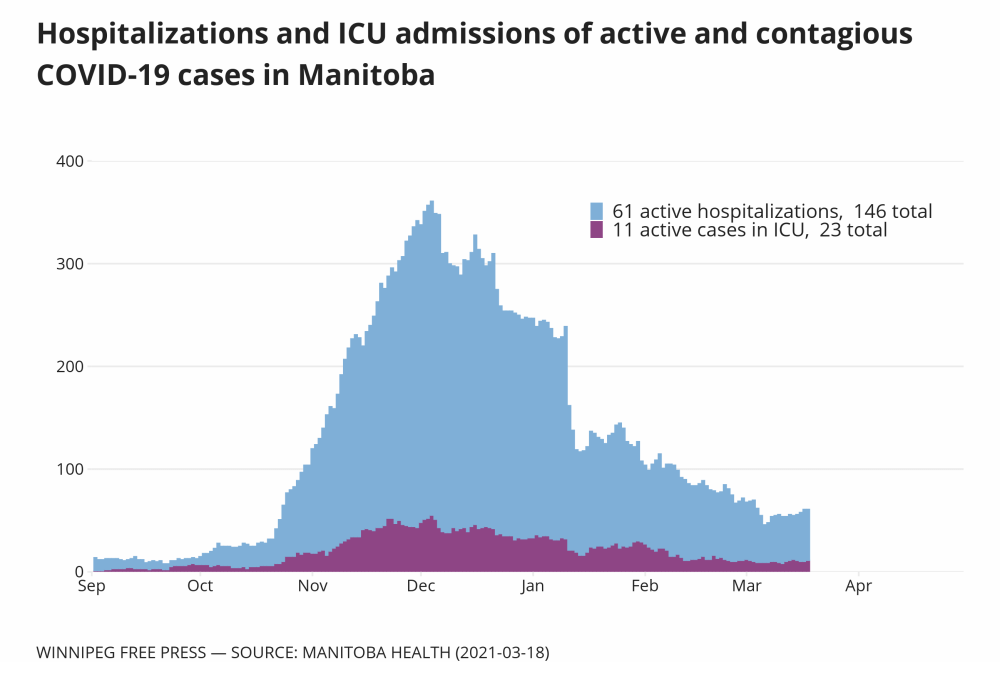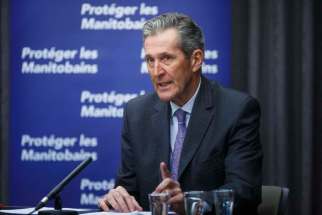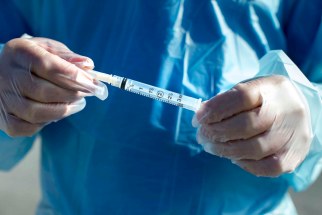Vaccination rates should chart reopening pace
Read this article for free:
or
Already have an account? Log in here »
To continue reading, please subscribe:
Monthly Digital Subscription
$0 for the first 4 weeks*
- Enjoy unlimited reading on winnipegfreepress.com
- Read the E-Edition, our digital replica newspaper
- Access News Break, our award-winning app
- Play interactive puzzles
*No charge for 4 weeks then price increases to the regular rate of $19.00 plus GST every four weeks. Offer available to new and qualified returning subscribers only. Cancel any time.
Monthly Digital Subscription
$4.75/week*
- Enjoy unlimited reading on winnipegfreepress.com
- Read the E-Edition, our digital replica newspaper
- Access News Break, our award-winning app
- Play interactive puzzles
*Billed as $19 plus GST every four weeks. Cancel any time.
To continue reading, please subscribe:
Add Free Press access to your Brandon Sun subscription for only an additional
$1 for the first 4 weeks*
*Your next subscription payment will increase by $1.00 and you will be charged $16.99 plus GST for four weeks. After four weeks, your payment will increase to $23.99 plus GST every four weeks.
Read unlimited articles for free today:
or
Already have an account? Log in here »
Hey there, time traveller!
This article was published 18/03/2021 (1728 days ago), so information in it may no longer be current.
The percentage of elderly Manitobans who have been vaccinated against COVID-19 should be a major factor when the province decides when — and how fast — to reopen the economy.
The Pallister government announced proposed changes Thursday that could result in a further loosening of pandemic restrictions, either just before or after Easter.
As in previous reopening plans, the changes are modest and science-based. They strike the right balance between health risks and the economic and mental health costs of maintaining restrictions.
The province is wisely keeping existing limits on social interactions between households (probably the biggest spreader of SARS-CoV-2) while offering modest relief to the hospitality and entertainment industry. Movie theatres may finally reopen and capacity limits on retail outlets could be eased.
The emphasis continues to be minimizing prolonged indoor contact between people not wearing face coverings. The proposals are reasonable, especially since hospitalization rates — including intensive care units — have been slowly falling for weeks.
No decisions have yet been made, but when they are, vaccination rates should be part of the debate.
Once a certain threshold of high-risk people are immunized — particularly the elderly — there will be less reason to maintain existing restrictions.
Public health officials have said consistently those over age 65-70 are at the highest risk of a severe outcome from COVID-19. Nearly one in five Manitobans over 70 who contract the disease die from it.
They are not the only ones. Many below that age with underlying health conditions are also at risk of severe outcomes.
Some are getting vaccinated through medical clinics and pharmacies. It’s a slow process and it’s not easy to track.
What the province can accurately monitor is the percentage of people vaccinated by age group.
The vast majority of Manitobans over 90, the highest-risk demographic, have received at least one dose of COVID-19 vaccine. There were an estimated 12,481 people over age 90 in Manitoba on July 1, 2020, according to Statistics Canada. As of Thursday, 12,957 Manitobans in that age group had received at least one dose (9,399 first dose, 3,558 second).
The news isn’t quite as good yet for those ages 80-89: about 35 per cent of the estimated 15,022 Manitobans in that demographic have received at least one dose (11,576 first, 3,446 second).
Only 9.8 per cent of those ages 70-79 have been inoculated.
The question public health officials have to answer is what percentage of elderly Manitobans should be vaccinated before reopening certain parts of the economy?
Those considerations should not be pondered in isolation; they have to be weighed against other factors, such as case numbers, test positivity rates, and hospitalizations but they should be part of the mix.
A large percentage of the most vulnerable people are now protected, including residents of personal care homes. Most front-line health-care workers are also vaccinated; that would help protect hospital capacity should there be a third wave.
The distribution of an effective vaccine means Manitoba’s situation is very different than it was in October 2020, after Thanksgiving, when cases skyrocketed and the province moved into code red restrictions.
The only protection against the novel coronavirus then was social distancing and donning masks. That’s not the case now.
A large percentage of the most vulnerable people are now protected, including residents of personal care homes. Most front-line health-care workers are also vaccinated; that would help protect hospital capacity should there be a third wave.
The daily vaccine distribution count is still relatively low, although it did start to ramp up this week. There were 4,794 doses administered Wednesday, the single biggest daily count to date.
It may not be the “firehose” approach Premier Brian Pallister promised, but it appears Manitoba has graduated from a squirt gun to a garden hose.
Vaccination rates may only be a small part of the reopening debate during this round of talks. But they should play an important role, once the vast majority of Manitoba’s highest-risk population has been jabbed in the arm.
tom.brodbeck@freepress.mb.ca

Tom has been covering Manitoba politics since the early 1990s and joined the Winnipeg Free Press news team in 2019.
Our newsroom depends on a growing audience of readers to power our journalism. If you are not a paid reader, please consider becoming a subscriber.
Our newsroom depends on its audience of readers to power our journalism. Thank you for your support.










